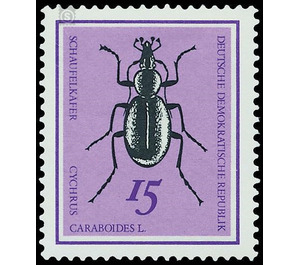Useful beetles - Germany / German Democratic Republic 1968 - 15 Pfennig
Theme: Animals
| Country | Germany / German Democratic Republic |
| Issue Date | 1968 |
| Face Value | 15.00 |
| Color | violet |
| Perforation | K 13 1/2: 13 |
| Printing Type | offset |
| Stamp Type | Postage stamp |
| Item Type | Stamp |
| Chronological Issue Number | 1154 |
| Chronological Chapter | GER-DDR |
| SID | 181277 |
| In 14 Wishlists | |
Useful Beetles The Ministry of Posts and Telecommunications of the German Democratic Republic issues six multicolored special postal stamps with pictures of useful beetles. Useful beetles The total number of beetles living in Central Europe is difficult to specify; Sure, there are a few hundred species. The difficulty arises not least from the fact that the concept of usefulness is difficult to define. There are many beetles that play an important role in the household of nature and are therefore indirectly useful. Many Silphidae (carrion beetles) eliminate animal carcasses, the dung beetles bring feces under the ground, Georyssidae and Heteroceridae eliminate organic sludge at pond and stream edges. These are very important and useful activities. This circumstance should not be forgotten when talking about beneficial beetles, because in general one thinks first of all of beetle species that play an important role in the natural control of pests of agriculture or the forest. Many ground beetles (Carabidae) eat the terrestrial pests living on and in the soil, many short - winged (Staphylinidae) and long - tailed beetles (Histeridae) kill fly larvae, not a few beetles (Nitidulidae), flat beetles (Cucujidae), almost all colored beetles (Cleridae) track the pests of the Woods in their brood lobes, ladybirds, the larvae of numerous species of soft beetles (Malachiidae), Cantharidae, Dasytidae, etc.) eat leaf and stem pests. The motif series shows some because of their usefulness to be gentle, but less beneficial as beetle species. 15 Pfennig value: Cychrus caraboides L. The Cychrus species are also among the common beetles (Carabidae) and are known under the name scoop beetle. The articulated buttons on the beetles' mouthparts have the shape of tiny narrow blades. Cychrus caraboides lives in Northern and Central Europe, where it inhabits especially the mixed and alluvial forests in relatively low population density. It can also be found in more open terrain. Cychrus has a very narrow long head and a much narrowed fore body, which makes his physique well adapted to the lifestyle. He specializes in snail food and, thanks to his slender front body and the long spoon-shaped buttons, he can crawl deep into the snail shells. The breathing holes are hidden at the side under the wing covers and thus protected against smearing by mucus of the snails. Like its 3 to 4 cm large black larvae, which eat ground animals, the beetle leads a nocturnal way of life. Snails often occur as garden and field pests. Since the scab beetles participate in their decimation, they must be regarded as beneficials. In North America, some scab beetle species have been detrimental to their dietary specialization, having crept into and finding plenty of food in "snail gardens" where snails are bred.


